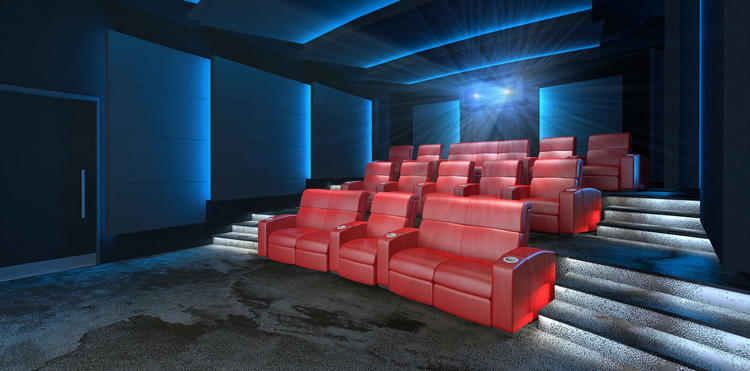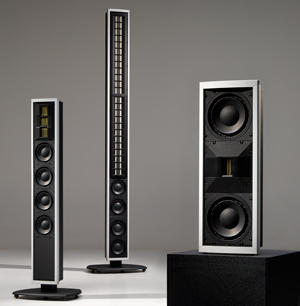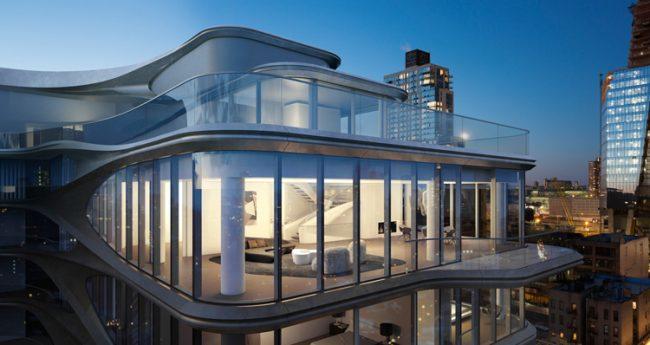Trending
Pass the popcorn
If you add up costs for the latest audio and video tech, prices for home theaters can run all the way up to $1 million

When enjoying a film about a galaxy far, far away, binge-watching Netflix’s “Making a Murderer” or throwing an 80’s-themed karaoke party, New York City luxury homeowners desire state-of-the-art custom screening rooms, which offer privacy and amenities that beat what the typical multiplex can deliver.
But the cost of admission to these private theaters is steep, with prices that can approach as high as $1 million for an incredibly tricked-out room with the latest technology like IMAX-quality projection, high-end speakers and sound dampening in walls and air ducts.
In some ways, the trend, which has been accelerating among the 1 percent for more than a decade, isn’t the most obvious fit for a New York City home. A dedicated screening room, or one that’s carved out of an existing living room, usually requires lots of leg room, which can be in short supply even in capacious apartments.
But don’t run out and buy a sprawling suburban McMansion to host your weekly “Billions” viewing party just yet, consultants, manufacturers and installers say. “The city is really no different. We just have to work with different size spaces,” said Allan Rohde, a manager of the Manhattan-based Bright Home Theater company.

Freestanding speakers from Wisdom Audio. The company also offers in-wall-mounted versions.
For the willing spender, there is a wide range of cutting-edge systems to consider. But what seems to have particularly galvanized interest among a subset of home-theater fans this winter is the imminent arrival of a home version of an IMAX system, the projection format known for its massive and sharply detailed images.
The new IMAX product, called the Palais, which is expected to ship this spring, has so far been purchased by 80 clients worldwide, according to a statement released by the firm in December. An IMAX showroom is set to open this year in New York City.
520 West 28th Street, the 39-unit condo designed by Zaha Hadid along the High Line, is slated to get a Palais, according to news reports.
But this version, which will feature a dozen high-backed white-leather chairs arranged in three ascending tiers, according to renderings, will be shared among the building’s homeowners.
An IMAX spokeswoman did not respond to a request for comment about the roll-out of Palais. But the systems do seem pricey, even in the rarified world of top-flight audio and video equipment.
A soup-to-nuts installation — that is, with an IMAX laser projector, a 16-by-18-foot screen, lighting and a half-dozen seats, plus seat fabric and carpets — will run $500,000, according to Theo Kalomirakis, whose Brooklyn-based TK Theaters specializes in home-theater design and partnered with IMAX on the design of the Palais. Of course with speakers, processors, sound dampening and building work, the price tag can easily double.
And keep in mind, he said, that although movies are increasingly being shot and shown in the IMAX format, audiences can’t always get their hands on hard copies. Films like “Star Wars: The Force Awakens,” for example, are available via streaming through a company called Prima Cinema for $500 for a one-time-only showing, Kalomirakis said.
Squeezing theaters into condos and co-ops can be tricky, said Kalomirakis, who helped create them in shared-amenity spaces at 15 Central Park West, 56 Leonard Street and 15 Broad Street.
“Theaters are something you’re going to find in the most luxurious homes, like you find bathrooms and kitchens.”
Ideally, a theater should be 12 by 16 feet, he said. Windows need to be covered, although using panels that are motorized to open like kitchen cabinets is an option, he explained.
Too-low ceilings can be another hurdle. In general, eight feet isn’t enough clearance for tiered seats, which should be one-and-half feet apart, but a 10-foot ceiling, the height of many condos, is often sufficient, he added. “Theaters are something you’re going to find in the most luxurious homes, like you find bathrooms and kitchens,” Kalomirakis said.
For those who would rather choose their components à la carte, there can be a dazzling and sometimes dizzying array of options, from boutique tech firms all over the world, experts say. But for those who want to emphasize sound over picture quality, in cases where theater equipment is also used to play music, an item-by-item approach may be useful, says Rohde of Bright Home.
His company is now in talks to install a home theater in a duplex penthouse in Manhattan, where the client wants to pair his 85-inch Sony XBR-model TV with the “best sound possible,” Rohde said. So he recommended a preamplifier from Trinnov, a French company that’s acclaimed for supporting 3D formats. Its top-of-the-line Altitude 32 model costs near $40,000.
And for speakers, he’s advised the client to consider Wisdom Audio, which offers speakers that can be positioned to flank a screen and also mounted inside a wall, for a less-obtrusive look. Wisdom’s Sage series starts around $10,000 for a pair.

520 West 28th Street, the 39-unit condo designed by Zaha Hadid along the High Line, is getting the IMAX Palais, according to news reports.
Meanwhile, Enigma Acoustics’ Mythology line has versions that can fit on bookshelves, which can also be useful in tight urban apartments ($15,000 a pair), he added. Calibrating this kind of equipment with existing televisions can cost $1,000, Rohde said.
Few homeowners likely want their children’s bedroom rattled by all that volume, which is why sound dampening, in walls and air ducts, is key, said Rob Friedland, an owner of SoundSight Technologies, a 20-year-old Manhattan-based company that employs outside contractors to soundproof theaters.
The look of theaters seems to be morphing by the year, he added. While movies used to be their main draw, sporting events seem more popular today. As a result, clients are opting for more casual layouts, favoring couches on the same level over multiple levels of seats, so viewers can more easily interact with one another during events like the Super Bowl.
In fact, for Friedland, only about one in 20 clients wants sloped movie-theater-like seating nowadays, he explained. But there hasn’t been much skimping. These clients “have a bit of money to spend,” he said, “and they like having toys.”




